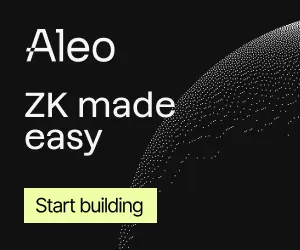In brief
- Rollups are a scaling solution that can lower transaction costs and increase throughput on a blockchain protocol.
- Rollups are a popular Layer-2 scaling solution for Ethereum.
- A zkEVM is a new type of zk-Rollup that is EVM compatible.
- The first two zkEVM options were released in March 2023. More zkEVM alternatives are in development (at the time of writing).
tl;dr (Don't worry if you don't understand, a full explainer follows): A zkEVM is an EMV-compatible rollup that is secured by a ZKP. Zero-Knowledge Rollups (zk-Rollups) are a type of rollup that uses Zero-Knowledge Proofs (ZKPs). A ZKP is a cryptographic proof that verifies the transaction data within a zk-Rollup is accurate.
The ZKP in a zk-Rollup enhances both the privacy and security of a rollup as this proof verifies the transactions in it — no trust or “optimism” is required. It is called “zero-knowledge” in the sense that you can verify the truth of all the data and transactions in a zk-Rollup — without needing to know the details of every transaction contained within it.
Background on zkEVMs
In order to understand zkEVMs, we need to go back a few blocks and explain this dense portmanteau of acronyms (zk-Rollups and EVMs). The Ethereum Virtual Machine (EVM) is the computing environment of the Ethereum blockchain. The EVM could be thought of as a decentralized virtual computer; this is why Ethereum is sometimes referred to as “the global supercomputer.” The EVM is where smart contracts and decentralized applications (dApps) on Ethereum interact with each other. Ethereum’s EVM is one of the core protocol features that has made it a pillar of the blockchain ecosystem.
What do rollups do?
Rollups bundle transactions in order to improve a blockchain’s throughput (data or transaction processing capability over a specific time frame) while lowering transaction costs at the same time. In essence, a rollup “rolls up” (combines) a number of transactions from a Layer-1 protocol (a blockchain like Ethereum) and executes them off-chain (not on the primary blockchain) using a Layer-2 protocol such as a sidechain or an EVM-compatible blockchain.
Some rollups are “optimistic,” meaning they are assuming (optimistically) that all the transactions in a rollup are valid and not fraudulent. For this reason, there is a period (typically several days) where one can challenge the validity of a transaction. Examples of Optimistic Rollup (ORs) for Ethereum include Optimism, Arbitrum, and Boba Network. While ORs significantly lower costs and increase transaction throughput, faulty transactions can get through if they are not challenged in a timely manner.
Popular zk-Rollup solutions include dYdX and Loopring. While these have security advantages, zk-Rollups tend to be a little more computationally expensive than ORs.
Comparing these two Ethereum rollup types, they both have some downsides. While ORs tend to be EVM compatible, they come with some concerns about fraud and security. While zk-Rollups tend to be praised for having better security, they generally can only used in specific transactions as they typically lack EVM compatibility; this means that zk-Rollups are limited to being used for bespoke processes that limit their adoption and use cases.
For these reasons, many have expressed the desire for a rollup that combines the best features of these alternatives into one solution; that solution is now here.
What are zkEVMs?
A zkEVM is an EMV-compatible rollup that is secured by a ZKP. This gives it the enhanced functionality of some of the Optimistic Rollup solutions that are EVM-compatible while also giving it the security of earlier zk-Rollup options that didn’t offer compatibility with Ethereum’s EVM. These new zkEVMs allow for enhanced Ethereum process functionality (smart contracts and dApps) while also lowering gas costs and increasing Ethereum network throughput.
Why Ethereum Needs zkEVMs
Ethereum as a blockchain has suffered at times from high transaction fees and transaction confirmation delays. Further, the Ethereum blockchain itself can not natively process more than approximately 30 transactions per second (TPS). Each rollup solution can increase transaction throughput by up to 2,000 TPS — or more. While Ethereum’s recent upgrade (called The Merge) will increase scalability, many expect Layer-2 scaling solutions such as rollups to remain popular for some time in order to ameliorate Ethereum transaction congestion issues. Scalability is one major benefit of zkEVMs.
While scalability had already been enhanced via earlier rollup iterations, zkEVMs combine this scalability with privacy, security, and enhanced interoperability. By combining ZKPs with EVM compatibility, zkEVMs keep the security and privacy-preserving features of zk-Rollups — while enhancing Ethereum interoperability by preserving EVM compatibility. This allows zkEVMs to be interoperable with smart contracts and dApps used on Ethereum. Further, these zkEVMs should also work on EVM-compatible blockchains such as Avalanche, Solana, and Fantom.
Like other rollup solutions, zkEVMs significantly lower transaction costs. At the time of writing, Ethereum transaction costs were approximately $0.90/transaction (when converted to USD). As zkEVMs can process hundreds — or thousands — of transactions in a batch off-chain, this transaction cost can be split amongst all the transactions in a rollup by simply verifying the proof of the rollup on Ethereum in a single transaction. This can lower the cost per transaction to less than $0.01 for simple solitary transactions — and a bundle of around 100 transactions could be executed for less than $0.10 worth of crypto.
Another big benefit of zkEVMs is their interoperability. Existing smart contracts and dApps can easily be migrated to a zkEVM to take advantage of rollup benefits — without requiring any coding changes. And because zkEVMs are verified on Ethereum just like other rollups, they have largely the same level of security as the native Ethereum blockchain protocol.
Polygon and zkSync’s zkEVMs
Launched just days apart in late March 2023, the first two zkEMVs to be released to the public were from zkSync and Polygon (on March 24th and 27th, respectively). In development since 2019, zkSync’s solution called zkSync Era went live to much fanfare and is the first zkEVM to be publicly available. The Polygon zkEVM is open source and Ethereum creator Vitalik Buterin was given the privilege of sending the first transaction following its public release.
Both options already have long lists of crypto projects that have indicated they plan to use one — or both — of these zkEVM solutions. It should be noted that while these zkEVMs have undergone significant security testing, both teams have cautioned that these are early versions that should initially be used carefully. Like the first iterations of other blockchain breakthroughs, they may go through some developmental growing pains and security upgrades over the coming years.
The Future of zkEVMs on Ethereum
While these are the first two zkEVMs to be available for public use, there are numerous other zkEVM projects in development with a public release on the horizon, including alternatives from Consensys, Scroll, and Taiko. While Ethereum continues to work towards on-chain scaling through future upgrades to its protocol, these upgrades can often be delayed significantly due to their requirements and technical complexity. Layer-2 solutions like zkEVMs are continuing to solve pain points for Ethereum as it continues its developmental goals of scalability, security, throughput, decentralization, and enhanced functionality.




